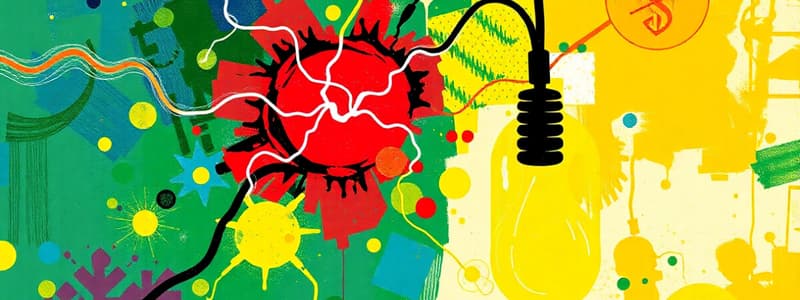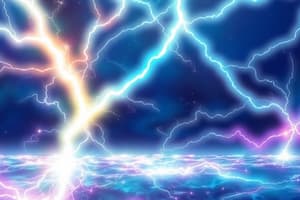Podcast
Questions and Answers
What does voltage measure in a circuit?
What does voltage measure in a circuit?
- The resistance within the circuit
- The speed of electrons
- The force pushing electrons (correct)
- The amount of current flowing
In Jacob's experiment, what represents the force or voltage when marbles roll down the tubes?
In Jacob's experiment, what represents the force or voltage when marbles roll down the tubes?
- The material of the tube
- The length of the tube
- The weight of the marbles
- Gravity acting on the marbles (correct)
How does the current behave when voltage increases?
How does the current behave when voltage increases?
- It becomes inconsistent
- It increases (correct)
- It decreases
- It remains constant
What characterizes direct current (DC)?
What characterizes direct current (DC)?
What happens to the electrical current when a battery runs out for a direct current device?
What happens to the electrical current when a battery runs out for a direct current device?
In Jacob's experiment with the feather and pencil, which will result in faster marble movement?
In Jacob's experiment with the feather and pencil, which will result in faster marble movement?
Which device is an example of a direct current application?
Which device is an example of a direct current application?
Which factor does NOT affect the current running through a circuit?
Which factor does NOT affect the current running through a circuit?
What must Jacob continuously do to maintain direct current in his marble tube demonstration?
What must Jacob continuously do to maintain direct current in his marble tube demonstration?
What does a longer tube represent in Jacob's marble experiment?
What does a longer tube represent in Jacob's marble experiment?
Flashcards
What is a circuit?
What is a circuit?
The path electricity flows through between two points.
What is voltage?
What is voltage?
The force that pushes electrons through a circuit to create electricity.
What is current?
What is current?
The flow of electrons through a circuit.
What is direct current?
What is direct current?
Signup and view all the flashcards
What is alternating current?
What is alternating current?
Signup and view all the flashcards
What is DC or direct current?
What is DC or direct current?
Signup and view all the flashcards
What is AC or alternating current?
What is AC or alternating current?
Signup and view all the flashcards
How is voltage measured?
How is voltage measured?
Signup and view all the flashcards
How is current measured?
How is current measured?
Signup and view all the flashcards
What is resistance?
What is resistance?
Signup and view all the flashcards
Study Notes
Jacob's Science Fair Project: Demonstrating Electricity
- Experiment Idea: Jacob's neighborhood experienced a power outage, sparking his interest in electricity. He designed a science fair project using marbles and a plastic tube to illustrate how electricity flows in a circuit.
Voltage
- Definition: Voltage is the force that pushes electrons through a circuit to create electricity.
- Measurement: Measured in volts.
- Demonstration: Jacob used tubes of different lengths to represent voltage differences. Marbles rolling down the longer tube demonstrate higher voltage due to greater gravitational force. A small toy might use 1.5 volts, while a construction excavator might use 24 volts.
Current
- Definition: Current is the flow of electrons through a circuit. Higher voltage leads to faster current.
- Demonstration: Jacob used tubes of equal length but different pushing forces (a feather vs. a pencil) to demonstrate how different voltages lead to different current speeds. The pencil, representing a stronger force/voltage, resulted in faster-moving marbles.
Direct Current (DC)
- Definition: Electrons flow in one direction.
- Demonstration: Marbles are added to one end of the tube, flowing down to the other end. This necessitates continuous supplying of marbles to maintain flow.
- Real-world examples: Electric cars, toys, flashlights, cell phones.
- Features: Flows steadily until the energy source (battery) depletes.
Alternating Current (AC)
- Definition: Electrons flow back and forth between two points.
- Demonstration: Jacob physically reversed the direction of marble flow in the tube.
- Real-world examples: Powering homes, office buildings, and large appliances.
- Features: Reuses electrons. Voltage drops as electrons change direction. Uses an alternator to convert mechanical energy into electrical energy.
Studying That Suits You
Use AI to generate personalized quizzes and flashcards to suit your learning preferences.




